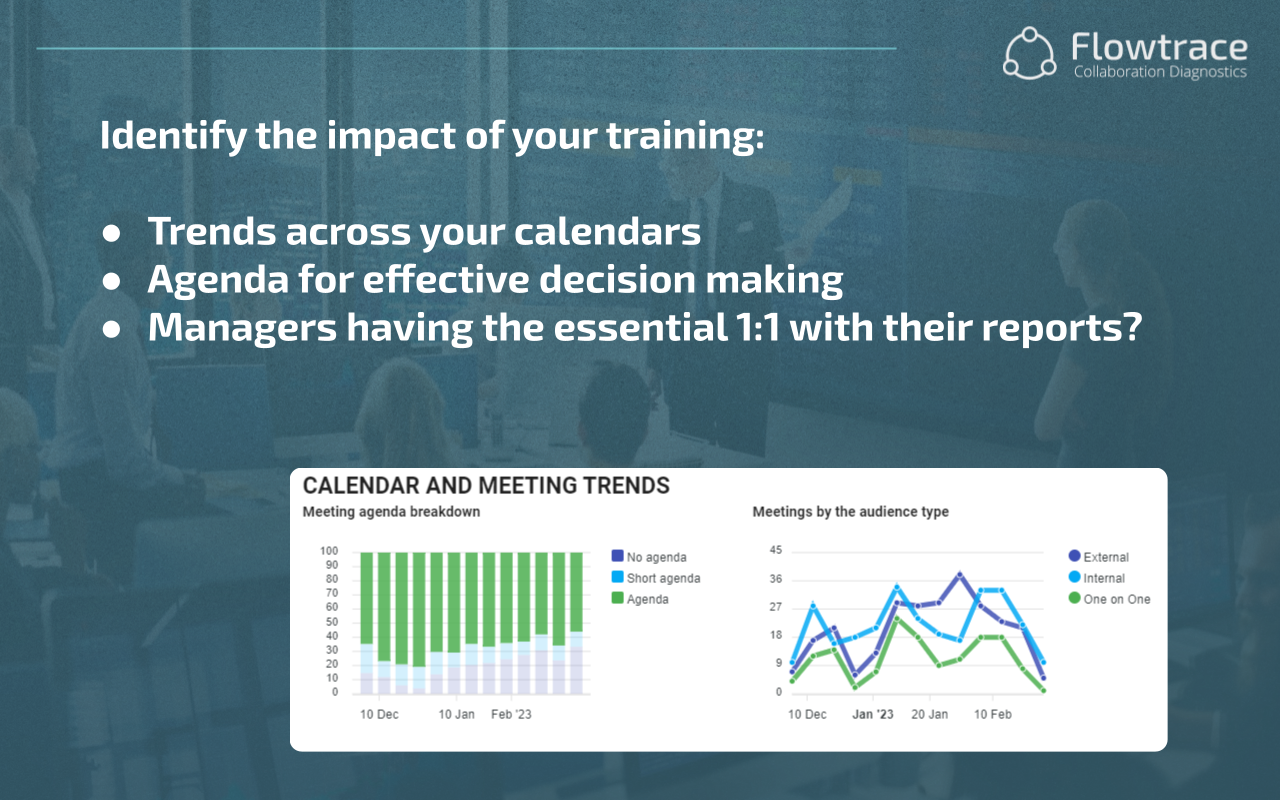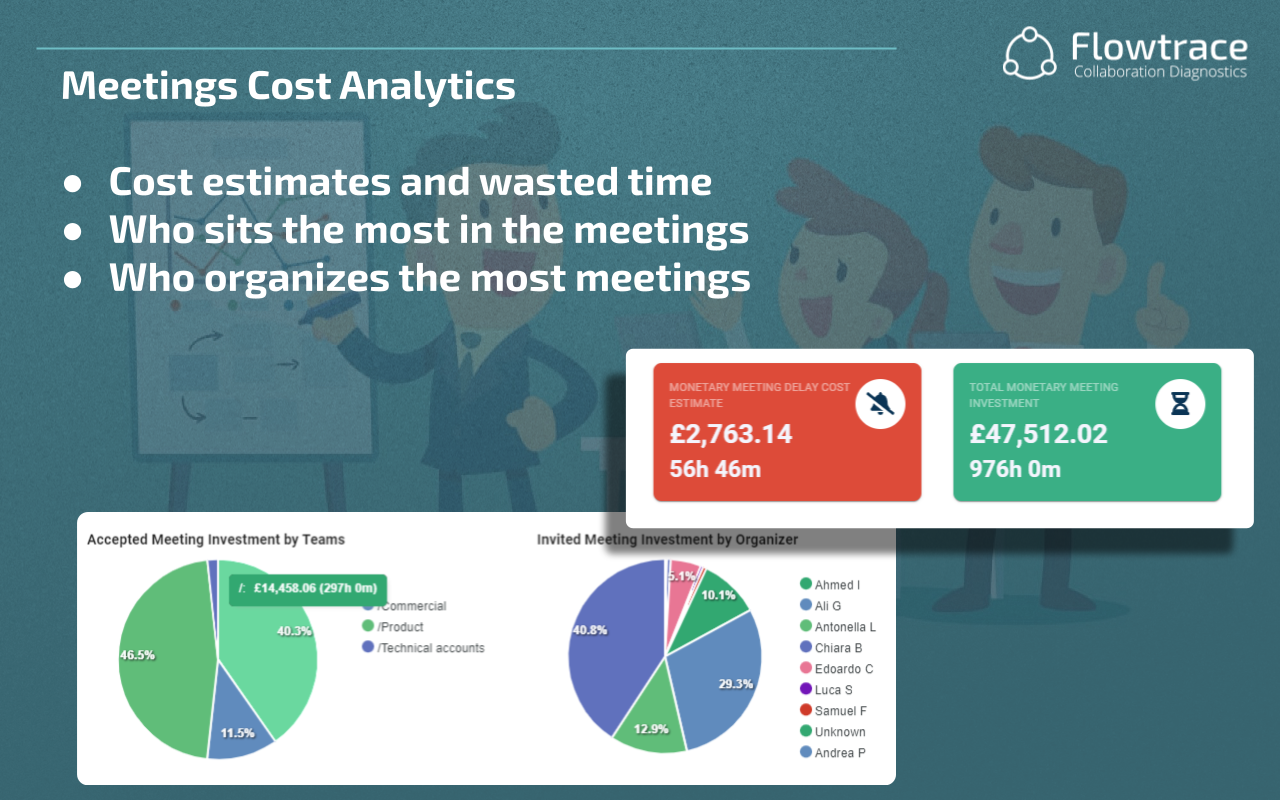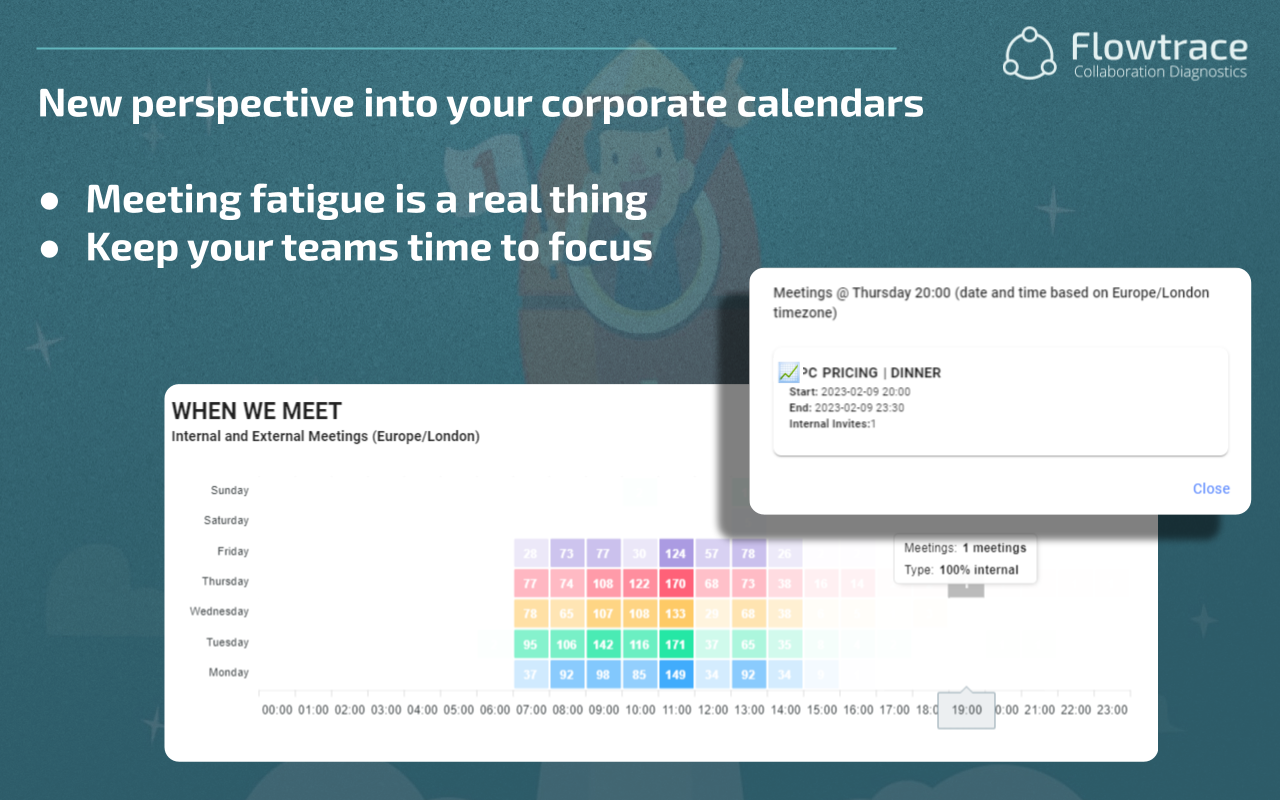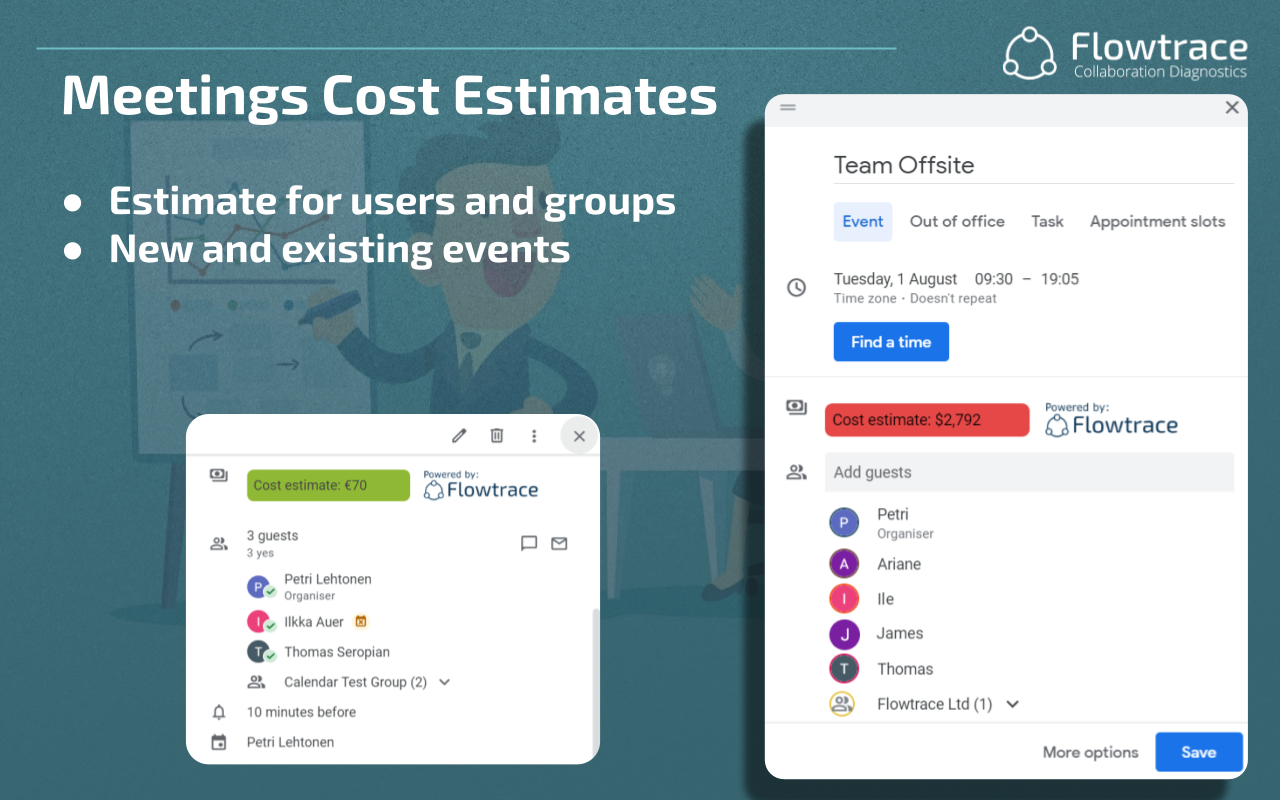The Meeting Metrics to Improve Your Meeting Culture
Learn how Flowtrace's meeting metrics can optimize schedules, track progress, and improve meeting culture to drive better business outcomes and boost...
Discover the staggering impact of poor quality meetings on productivity and employee engagement. Learn how Flowtrace's meeting analytics can transform your meeting culture.
As it stands, meetings have become a ubiquitous part of our work lives. They serve as a platform for collaboration, decision-making, and information sharing. However, not all meetings are created equal. Poor quality meetings - those lacking clear objectives, overrun with unnecessary details, or filled with disengaged participants - can have a detrimental impact on an organization's productivity and employee morale.
The global culture of poor quality meetings is a growing concern. With the advent of the pandemic and the subsequent shift to remote work, the dynamics of meetings have changed significantly. While the number of meetings has increased, their average duration has decreased. This shift has brought about new challenges in maintaining meeting quality and ensuring effective collaboration.
This article delves into the data behind poor quality meetings, drawing on research and statistics from reputable sources such as Timely, HR Digest, Harvard Business Review, Condeco, The Muse, Atlassian, National Bureau Of Economic Research and Doodle. We'll explore the impact of poor quality meetings on employee engagement, productivity, and the overall meeting culture within organizations.
Understanding the true cost of poor quality meetings is the first step towards improving them. By shedding light on the startling meeting statistics, we aim to provide a compelling case for organizations to reassess their meeting culture and take proactive steps towards improvement. Whether you're a team leader, a manager, or an employee, this comprehensive guide will equip you with the insights you need to transform your meetings from time-wasting obligations into productive, engaging, and meaningful collaborations.
The global culture of poor quality meetings is a pressing issue that demands our attention. Across industries and continents, ineffective meetings are draining resources, hindering productivity, and fostering employee disengagement. The data we've compiled from leading research sources paints a startling picture of this pervasive problem.

According to a survey conducted by Harvard Business School, the pandemic has led to a 13.5% increase in the number of meetings attended by an average worker. While the shift to virtual meetings has allowed for more frequent touchpoints, it has also amplified the challenges associated with meeting quality. The same survey found a 20.1% decrease in the average length of meetings, suggesting that while meetings have become more frequent, they may also have become less substantive.
In 2020, 36% of meetings were found to last just 30 minutes, while only 20% ran for a full hour. The second most common meeting length was a mere 15 minutes, accounting for 31% of all meetings. This trend towards shorter, more frequent meetings could be contributing to meeting fatigue and reducing the potential for meaningful collaboration and decision-making.
Moreover, the sheer volume of meetings is staggering. With 11 million meetings held each day, 55 million per week, and 220 million per year, it's clear that meetings have become a dominant feature of our work lives. However, the quantity of meetings does not necessarily translate into quality. A significant portion (50%) of these meetings are likely to be unproductive, leading to wasted time and resources.
As we can combine, the global impact of poor quality meetings is profound, affecting not only individual productivity but also organizational performance. As we navigate the evolving landscape of work, it's crucial that we address this issue and strive to improve the quality of meetings.
The COVID-19 pandemic has significantly reshaped the way we work, and meetings have not been exempt from this transformation. As organizations worldwide transitioned to remote work, the dynamics of meetings underwent a noticeable shift. The data reveals some intriguing trends that have emerged during this period.

A study conducted by Harvard Business School found that the number of meetings attended by an average worker rose by 13.5% during the pandemic. This increase suggests that as physical office interactions decreased, virtual meetings filled the gap, becoming a primary means of communication and collaboration.
Interestingly, while the frequency of meetings increased, their average duration decreased. The same study found a 20.1% reduction in the average length of meetings. This trend could be attributed to the recognition of 'Zoom fatigue' or the attempt to accommodate the challenges of remote work, such as managing work-life balance and dealing with potential distractions at home.
In 2020, the most common meeting duration was found to be 30 minutes, accounting for 36% of all meetings. Only 20% of meetings ran for a full hour, and the second most common meeting length was a mere 15 minutes, accounting for 31% of all meetings. This shift towards shorter, more frequent meetings could be a response to the challenges of maintaining engagement and focus in a virtual setting.
As we all have experiences, the pandemic has undeniably influenced meeting trends, leading to more frequent but shorter meetings. As we continue to navigate the world of remote work, understanding these trends can help us adapt our meeting practices to maximize productivity and collaboration.
The cost of poor quality meetings extends far beyond the time spent in the meeting room or on a video call. These meetings can have a significant impact on an organization's bottom line, employee productivity, and overall morale. The statistics we've compiled highlight the magnitude of this growing issue.

Consider the sheer volume of meetings: 11 million each day, 55 million per week, and 220 million per year. With 15% of an organization’s time spent in meetings, a figure that has been increasing annually since 2008, the cumulative cost is staggering. Middle managers spend 35% of their time in meetings, while upper management spends a whopping 50% of their time in these gatherings. This represents a significant portion of their workweek that could be utilized for other productive tasks.
The cost of meeting preparation is another factor to consider. Research suggests that employees spend an average of 4 hours per week preparing for status update meetings. This preparation time, combined with the time spent in the meetings themselves, can significantly reduce the time available for other work.
Moreover, the impact of poor quality meetings on employee productivity and engagement cannot be overstated. A survey found that 67% of employees believe that spending too much time in meetings hinders their productivity. More than 35% of employees reported wasting 2 to 5 hours per day on meetings and calls, with nothing to show for it.
When summing things up, the cost of poor quality meetings is a multifaceted issue that affects not only financial resources but also employee time, productivity, and morale. Addressing this issue is crucial for organizations seeking to improve their efficiency and create a more engaging and productive work environment.
Ineffective meetings are a significant contributor to employee disengagement, a factor that can have far-reaching implications for an organization's productivity and overall work environment. The data we've compiled provides a clear picture of the extent of this issue.
On average, most employees attend 62 meetings per month, with half of these meetings deemed a complete waste of time. This statistic is alarming, considering that meetings are intended to facilitate collaboration and decision-making. When meetings fail to serve their purpose, they can lead to frustration and disengagement among employees.
Executives are not immune to this issue. They consider 67% of meetings a complete failure in communicating the sole purpose of conducting them. This lack of clarity and purpose can lead to confusion and disinterest, further exacerbating employee disengagement.
The issue of multitasking during meetings is another indicator of disengagement. A survey suggests that 92% of employees find themselves multitasking during meetings, with 41% of respondents confessing that they often multitask or all the time during a meeting. This behavior suggests a lack of engagement and focus, which can significantly reduce the effectiveness of meetings.
Moreover, a staggering 91% of employees have admitted to daydreaming during their meetings. In comparison, 45% felt overwhelmed by the sheer number of meetings they attended. These statistics highlight the extent of disengagement and dissatisfaction associated with poor quality meetings.
As a summary, ineffective meetings can significantly contribute to employee disengagement, leading to a decrease in productivity and morale. Addressing this issue is crucial for organizations seeking to foster a more engaging and collaborative work environment.
A poor meeting culture can have a profound impact on productivity within an organization. When meetings are ineffective, they not only waste time but also drain energy, stifle creativity, and hinder decision-making. The data we've compiled underscores the extent of this productivity drain.

A survey of 182 senior managers found that 71% of them feel that meetings are unproductive. This sentiment is echoed by 45% of senior executives who believe that productivity could be increased if meetings were limited to at least one day a week. These statistics highlight the widespread belief that many meetings are unnecessary and contribute to wasted time and resources.
The issue extends beyond the meetings themselves. Managers and professionals lose 30% of their time in meetings that could have been invested in other productive tasks. This lost time represents a significant productivity drain that can affect an organization's overall performance.
Ineffective meetings also have a psychological impact on employees. After sitting through a useless meeting, an employee needs some time to recover, affecting their productivity for the rest of the day. In fact, 44% of participants in a survey said that sudden or unscheduled meetings mean that they do not have enough time to focus on their work.
Furthermore, the lack of focus during meetings is a significant issue. A staggering 95% of meeting attendees lose focus and miss parts of the meeting, while 39% doze off at meetings. This lack of engagement and attention can significantly reduce the effectiveness of meetings and lead to miscommunication and confusion.
As we see, a poor meeting culture can significantly drain productivity within an organization. Addressing this issue is crucial for organizations seeking to improve their efficiency and create a more engaging and productive work environment.
The data we've explored paints a clear picture of the challenges associated with poor quality meetings. From wasted time and resources to employee disengagement and productivity drain, the impact of ineffective meetings is far-reaching. However, the good news is that these challenges can be addressed, and the path to improved meeting culture is within reach.

Flowtrace offers a powerful solution to these challenges. Our Meeting Analytics for Google Calendar, available as a freemium or paid plan, provides the tools you need to transform your meeting culture. With Flowtrace, you can gain valuable insights into your meetings, identify areas for improvement, and implement effective strategies to enhance productivity and engagement.
Flowtrace’s Google Chrome Extension and Microsoft Outlook Add-In are powerful tools designed to provide real-time analysis of meeting costs directly within calendar applications, allowing a different viewpoint on meeting culture. The Microsoft Outlook meeting analysis tools, for instance, help teams understand the financial implications of meetings in real time with a clear view of associated costs. This integration allows users to see the financial impact of their meetings at a glance, making it easier to identify and eliminate unnecessary or unproductive meetings.

These tools are beneficial for several reasons:
Using these meeting cost calculators, leaders can foster a more efficient and productive meeting culture, ultimately benefiting the organization’s bottom line.
Moreover, Flowtrace empowers you to tackle the issue of employee disengagement. By identifying patterns of disengagement and providing actionable insights, our app enables you to foster a more engaging and collaborative meeting culture.
The journey to improved meeting culture begins with a single step. By choosing Flowtrace, you're taking that step and committing to a more productive and engaging future for your organization. Start using Flowtrace today and experience the transformative power of effective meetings.
Learn how Flowtrace's meeting metrics can optimize schedules, track progress, and improve meeting culture to drive better business outcomes and boost...
Improve meeting culture with meeting OKRs and Flowtrace analytics. Learn 10 examples to enhance productivity, engagement, and collaboration in...
Transform unproductive meetings with actionable insights and improve productivity and collaboration with Flowtrace's meeting analytics solutions....